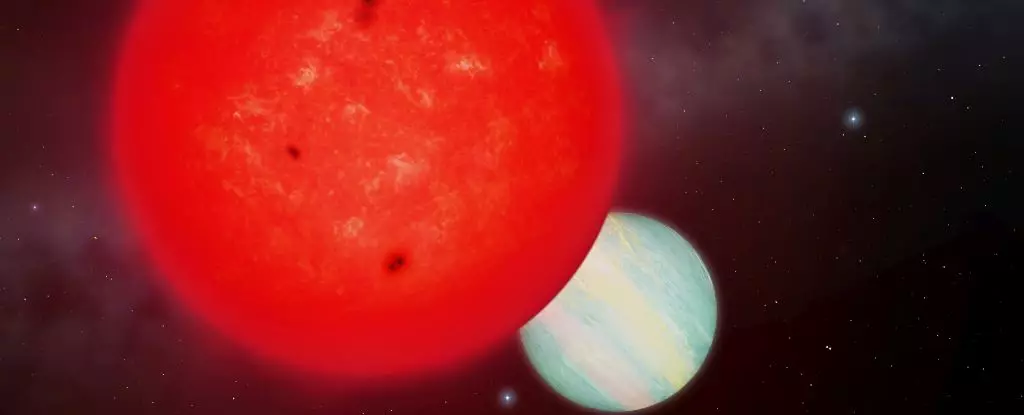In an astonishing revelation, astronomers have unearthed a remarkable astronomical anomaly that challenges long-held beliefs concerning the formation of planets. The discovery of TOI-6894b, a gas giant comparable in size to Saturn, orbiting a diminutive red dwarf star merely a fraction of the Sun’s size, has stirred a sea of curiosity and excitement within the astrophysics community. This finding is more than just an isolated marvel; it serves as a pivotal reminder that our understanding of planetary systems is still in its infancy, ripe for exploration and revision.
Traditionally, smaller stars, especially red dwarfs, were deemed incapable of producing large planetary bodies due to a presumed scarcity of material. The standard paradigm suggested that the mass of the stellar body directly correlates with the volume of material available for planet formation. Yet TOI-6894b stands as a testament to the universe’s unpredictability, showing that such seemingly impossible phenomena might be more commonplace than previously thought.
The Astounding Characteristics of TOI-6894b
TOI-6894b boasts an impressive radius of around 86 percent that of Jupiter, while its host star, TOI-6894, is an astonishingly small entity, consisting of only 21 percent of the Sun’s mass. The discovery was nearly serendipitous, originating from a comprehensive search of over 91,000 red dwarf stars conducted by an international team led by Edward Bryant from the University of Warwick. By employing cutting-edge telescopes, including the European Southern Observatory’s Very Large Telescope (VLT), the team confirmed the existence of this unexpected gas giant.
What sets TOI-6894b apart is the standout feature of its parent star’s light dimming by a remarkable 17 percent, an anomaly that enabled astronomers to determine the size of both the star and the planet with relative precision. Such pronounced transits not only make for exciting observations but also suggest that TOI-6894b possesses an intriguing atmospheric composition that researchers are keen to study further.
The Implications of Newly Discovered Gas Giants
The significance of TOI-6894b extends far beyond its size or orbital mechanics; it serves as a critical case study in understanding planetary formation pathways. Traditionally, gas giants are thought to form through two primary mechanisms: gradual accumulation or direct collapse under instability within the protoplanetary disk. Interestingly, TOI-6894b doesn’t comfortably fit into either of these categories, leading researchers to question existing models and explore new theories that can account for such extraordinary formations.
This case also resonates deeply with the ongoing exploration of atmospheric studies of exoplanets. Scientists are gearing up to use the James Webb Space Telescope (JWST) to assess the planet’s atmosphere and look for chemical signatures, such as methane, which could yield valuable insights into its composition and formation history. The very existence of TOI-6894b is a dynamic reminder of how much more there is to learn about the diverse environments that may host life and the processes that lead to the creation of planetary systems.
Redefining Our Cosmic Perspective
As scientists continue to push the boundaries of astronomical observation, discoveries like TOI-6894b encourage a broader contemplation of our place in the universe. This gas giant, revolving around a relatively inconspicuous star, signifies that even the most peculiar cases can offer transformative insights. The unexpected juxtaposition of a gas giant with a small host star implores researchers to reconsider stellar masses’ roles in planetary formation.
The discovery also reinforces a critical message: our understanding of the cosmos is ever-evolving. As we focus on unveiling more secrets hidden within the fabric of space, the necessity for innovative thinking becomes paramount. This dynamic field will continually challenge our scientific framework, suggesting that our cosmic narrative is far from complete.
The Road Ahead: Exploring More Cosmic Mysteries
Looking forward, the community should be galvanized by the prospect of unearthing more exoplanets like TOI-6894b. Each find provides not just data points on a graph but invaluable narratives about the formation and evolution of planetary systems. The potential for more groundbreaking discoveries beckons, urging scientists to delve deeper into the terrestrial phenomena and the exotic possibilities that lie beyond our solar system.
In sum, TOI-6894b serves as an emblem of cosmic wonder and inquiry. It is a prompt for emerging scientists and seasoned researchers alike to approach their inquiries with refreshed perspectives and an openness to the marvelous complexities of the universe. Each revelation enriches our understanding and continues to push the edges of science towards an enlightened tomorrow.

